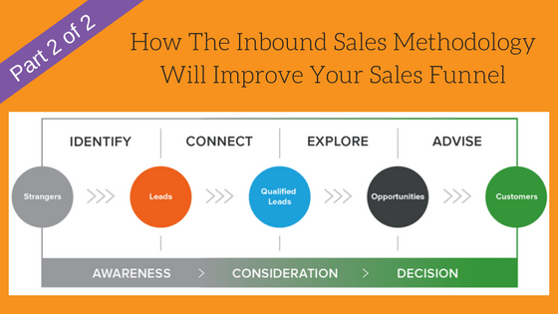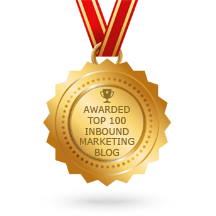
This is the second in a two-part series exploring the Inbound Sales Methodology, how it works and why it’s so important to the future of your business.
Last week we introduced the idea of the Inbound Sales Methodology, and how the changing marketing landscape has led to an inevitable transformation in modern sales.
Pushy sales tactics no longer work on the empowered buyer. The balance of power has shifted, and today’s sales teams are required to build a sales process that not only aligns the buyers’ journey but to also add value, over and above what they can learn online themselves. This new process is known as Inbound Sales.
But how exactly does the Inbound Sales Methodology work? This week we explore the processes and practicalities of the modern sales person and reveal the 4 steps in the Inbound Sales Methodology.
The Inbound Sales Methodology in 4 Steps
Step 1: Identify
I am constantly surprised by the number of companies that are still cold calling. And when I say cold calling, I’m talking about reaching out to sell something to an individual or business that has no need for their product or service, and has never asked for it nor indicated interest at any time.
Thankfully there is a better way to identify people who are likely to buy from you.
The key is to identify people who have already started the buyers’ journey, according to Inbound Sales expert, Mark Roberge.
To successfully identify these people start by understanding your buyer personas, and the buyers’ journey.
Once you know what trigger events cause someone to need your product, or service, you can begin to listen to the market for these signs. For example, an ideal customer may land a new client or contract, or they’re about to go to market with a new product. Perhaps they’ve started a new job, or the company has won an award or received grant funding.
Trigger events could also be outside factors like severe weather, a change in economics or recent changes to legislation that may mean people are either actively looking, or open to listening to solutions that will make their jobs easier.
It’s a much more strategic approach to understanding who might need your product or service.
Step 2: Connect
The next step is to connect with these people, but the key is to add value. And the only way you can add value is to properly understand their situation.
When you reach out to connect with your buyers, start with a message personalised to their situation. You will develop trust and credibility you’re your buyers if you show a genuine interest in helping them.
LinkedIn is a great place to connect with your ideal buyers to build a relationship. Here’s an example of a connect message you could send via LinkedIn:
“I see you just changed jobs and are now responsible for the entire finance department – I recently published an article called:
‘How to improve productivity of your staff’, which I thought you may find helpful, click here to read it.”
It’s a non-pushy icebreaker that indicates you’re more interested in helping them than meeting your sales quota. I would recommend you follow up after a day or two, if you don’t hear back from them, to see if they found it helpful. A very short personal email is all that is needed at this point. For example: “Hi Jon, Just a quick note to see if you had time to read the article I sent you the other day and if you found it helpful?” What you’re trying to do is get them to reply, to show they’re interested, so you can book in a meeting – we call this the Exploratory Call.
Step 3: Explore
The next step is to schedule an exploratory meeting so you can better understand their needs, and determine if you truly can help them. This meeting can be a simple phone call, or a casual coffee where their deeper buying goals are revealed.
Traditional selling has this the other way around. Unsolicited sales calls from a telemarketer or sales rep spruiking how good their service or product is – with little context to whom they’re speaking and how it will help them. These tactics are expensive because they have a higher close rate and can damage a brand’s reputation.
Exploring is all about discovering why a solution is necessary, what is your buyer trying to achieve, why is it important, what happens if they don’t find a solution, what is their budget and who are the key decision makers? This information helps you align your product or service to their specific needs.
Step 4: Advise
This is the final step in the Inbound Sales Methodology where you present how you can help them. Advise them on the right solution that meets their goals, timeframes and budget.
Traditional sales people give the same presentation to all buyers, and start by talking about how good their company, brand, product or solution is. By sticking to a generic script, legacy salespeople fail to represent their strategy as a solution to their prospect’s specific needs.
The Advise step is an opportunity to recap what you’ve learned about them in recent conversations or correspondence, demonstrating that you have been listening to them and are qualified to advise a solution that will meet their needs. Your solution is best presented visually either in person or virtually.
After you have recapped what they said about their needs, share how your product or service can help. It’s important to be specific, and to directly link your solutions to their unique problems. Then, make sure you include any awards and/or names of past customers this will demonstrate your track record, and prove that you are a trusted provider.
Finally, make sure you’re prepared for the sale – have the necessary paperwork, agreements or steps ready to close the sale.

